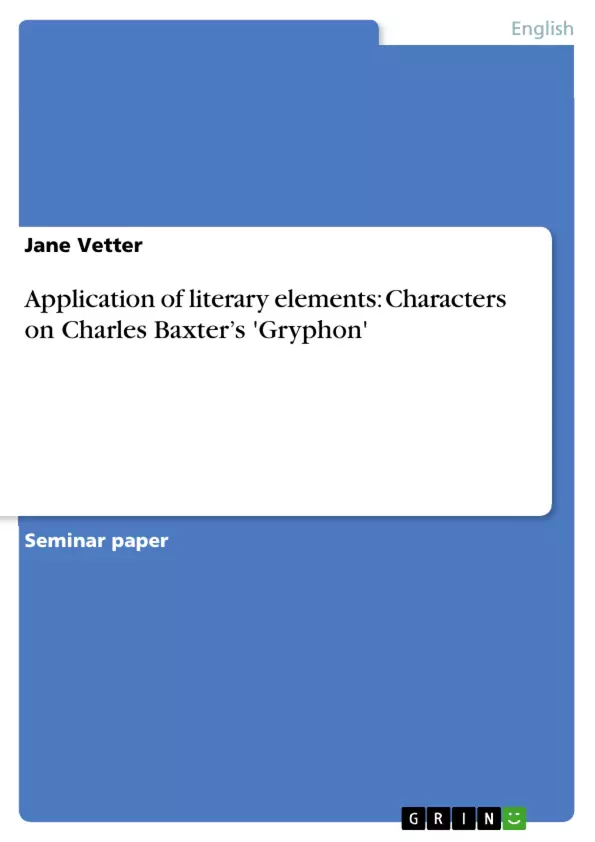Fictional characters often appear to readers as real people with authentic actions, thoughts and speech even though they are an author’s construct, intended to help a story to develop, to deepen and to come to life. Writer Robert DiYanni reasons in his book Literature: Approaches to Fiction, Poetry, and Drama that readers have to look into characters in order to find out more about “their function and significance in the story.” (54)
But what exactly is a character? The website Merriam-Webster Online defines character as “one of the persons of a drama or novel”, and “a person marked by notable or conspicuous traits.” Victoria Henderson, a student of the University of North Carolina, further points out within the Glossary of Literary Terms that “[c]haracters are extremely important because they are the medium through which a reader interacts with a piece of literature. Every character has his or her own personality, which a creative author uses to assist in forming the plot of a story or creating a mood.”
According to DiYanni, characters can be identified as major and minor, static and dynamic (54). The major character is the dominating core of a story and is also known as protagonist “whose conflict with an antagonist may spark the story’s conflict.” (54) Minor characters are generally used to support and illuminate the more significant individuals within the story (54).
Table of Contents
- Character
- Characters in "Gryphon"
- Mister Hibler
- Miss Ferenczi
- Tommy
Objectives and Key Themes
This paper analyzes the characterization techniques used in Charles Baxter's short story "Gryphon," focusing on the portrayal of the main characters and their impact on the narrative. The analysis uses established literary theory to classify and interpret the characters within the story's context.
- Character types in fiction (major/minor, static/dynamic, flat/round)
- Techniques of characterization
- Analysis of character roles in "Gryphon"
- The impact of characterization on narrative development
- The contrast between realistic and fantastical elements in character portrayal.
Chapter Summaries
Character: This chapter introduces key literary theories related to characterization, drawing on the works of DiYanni, Henderson, Madden, and Stauffer. It defines and differentiates major/minor, static/dynamic, and flat/round characters, explaining how authors utilize various techniques (narrative summary, description, physical appearance, action, speech, and consciousness) to reveal character traits and build a compelling narrative. The chapter sets the theoretical groundwork for the subsequent analysis of characters in Baxter's "Gryphon."
Characters in "Gryphon": This section applies the theoretical framework established in the previous chapter to analyze the characters in Charles Baxter's "Gryphon." It focuses on three central characters: Mister Hibler (the regular teacher), Miss Ferenczi (the eccentric substitute teacher), and Tommy (the narrator). The analysis examines each character's role in the story, exploring their traits, actions, and the ways in which they contribute to the overall narrative's themes and development. The chapter explores how Baxter uses characterization to create both realistic and fantastical elements within the narrative, adding depth and complexity.
Keywords
Characterization, literary analysis, Charles Baxter, Gryphon, short story, major character, minor character, static character, dynamic character, flat character, round character, narrative techniques, protagonist, antagonist, character development, realistic fiction, fantastical elements.
Frequently Asked Questions: Analysis of Characterization in Charles Baxter's "Gryphon"
What is the purpose of this document?
This document provides a comprehensive preview of a scholarly paper analyzing characterization techniques in Charles Baxter's short story, "Gryphon." It includes a table of contents, objectives and key themes, chapter summaries, and keywords. The analysis focuses on the portrayal of the main characters and their impact on the narrative, using established literary theory.
What are the key themes explored in the analysis?
The analysis explores various aspects of characterization, including character types (major/minor, static/dynamic, flat/round), techniques of characterization (narrative summary, description, physical appearance, action, speech, consciousness), the analysis of character roles in "Gryphon," the impact of characterization on narrative development, and the contrast between realistic and fantastical elements in character portrayal.
Which characters are analyzed in detail?
The analysis focuses on three central characters from Charles Baxter's "Gryphon": Mister Hibler (the regular teacher), Miss Ferenczi (the eccentric substitute teacher), and Tommy (the narrator). The analysis examines each character's role, traits, and actions, and how they contribute to the narrative's themes and development.
What theoretical framework is used in the analysis?
The analysis draws on established literary theories related to characterization, referencing the works of DiYanni, Henderson, Madden, and Stauffer. The chapter on character introduces key concepts such as major/minor, static/dynamic, and flat/round characters, and explains how authors use various techniques to reveal character traits.
What is the structure of the paper?
The paper is structured into chapters focusing on "Character" (introducing key literary theories on characterization) and "Characters in 'Gryphon'" (applying the theoretical framework to analyze the characters in Baxter's story). The preview also includes a table of contents and a list of keywords.
What are the key keywords associated with this analysis?
Key keywords include: Characterization, literary analysis, Charles Baxter, Gryphon, short story, major character, minor character, static character, dynamic character, flat character, round character, narrative techniques, protagonist, antagonist, character development, realistic fiction, and fantastical elements.
What is the intended audience for this analysis?
This analysis is intended for academic use, supporting the structured and professional analysis of themes within the short story "Gryphon".
- Arbeit zitieren
- Jane Vetter (Autor:in), 2005, Application of literary elements: Characters on Charles Baxter’s 'Gryphon', München, GRIN Verlag, https://www.grin.com/document/116456



